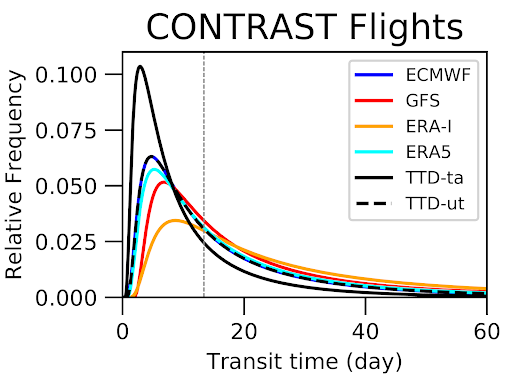Development of a Chemical Observation-Based Diagnostic for Convective Transport
Atmospheric convection not only affects weather patterns but also redistributes chemical species vertically. Deep convection can loft chemically active species emitted at Earth’s surface to the upper troposphere (UT) and in some cases even lower stratosphere, where the resulting composition change may have implications for chemical processing and climate perturbation. Convection and convective transport are challenging processes to observe and model because of their spatial and temporal scales. The airborne field campaign CONTRAST (CONvective Transport of Active Species in the Tropics) conducted over the convectively-active Tropical Western Pacific (TWP) region in January-February 2014 (Pan et al., 2017) provided a wealth of information from in situ chemical observations for advancing this area of research. Recent work using CONTRAST data has successfully developed a method for diagnosing convective transport.
The new diagnostic, characterizing the rapid convective uplift by the transit time distribution of the sampled air parcels (Luo et al., 2018; Chelpon et al., 2021), uses information embedded in the relationship between species UT fraction and chemical lifetime in 42 selected volatile organic compounds (VOCs) measured by the TOGA and AWAS instruments, as shown in Figure 1. Development of this diagnostic is enabled by the large range of chemical lifetimes spanned by the measured species, which range from hours (e.g. acetaldehyde, lifetime ~8 hours), to weeks (e.g. bromoform, lifetime ~20 days) and decades (chlorofluorocarbons, lifetimes ~100 years). Measurements of species with shorter lifetimes are particularly valuable for characterizing the impact of short-lived transport processes such as convection. The progress made in understanding the uncertainties of the diagnostic (Chelpon et al., 2021) enables the applications of the diagnostics for local and regional scales, supported by Smith et al., (2021).
A companion study (Smith et al., 2021) serves as the first application of the diagnostic to an evaluation of trajectory model transport analysis using grid point wind fields in atmospheric (re)analyses products. The same in situ measurement locations taken during CONTRAST are chosen for the initiation of backward trajectories, which are calculated using the wind fields of four (re)analysis datasets, including the ERA5. These backward trajectories define an explicit (modeled) representation for the convective transport pathways and time scales corresponding to each sampled air parcel. The results of the evaluation are shown in Figure 2 and indicate that the chosen wind fields generally represent the systematic behavior of convective transport observed over the TWP region. The use of the chemical observation-based transit time diagnostic for evaluation of simulated backward trajectories demonstrates its capability to connect observations and models, and supports the future application of the new diagnostic to evaluate transport in chemistry-climate models.


References:
Chelpon, S. M., Pan, L. L., Luo, Z. J., Atlas, E. L., Honomichl, S. B., Smith, W. P., et al. (2021). Deriving tropospheric transit time distributions using airborne trace gas measurements: Uncertainty and information content. Journal of Geophysical Research: Atmospheres, 126, e2020JD034358. https://doi.org/10.1029/2020JD034358
Luo, Z. J., Pan, L. L., Atlas, E. L., Chelpon, S. M., Honomichl, S. B., Apel, E. C., ... & Hall, S. R. (2018). Use of Airborne In Situ VOC Measurements to Estimate Transit Time Spectrum: An Observation‐Based Diagnostic of Convective Transport. Geophysical Research Letters, 45(23), 13-150.
Pan, L. L., Atlas, E. L., Salawitch, R. J., Honomichl, S. B., Bresch, J. F., Randel, W. J., ... & Wolfe, G. (2017). The convective transport of active species in the tropics (CONTRAST) experiment. Bulletin of the American Meteorological Society, 98(1), 106-128.
Smith, W. P., Pan, L. L., Honomichl, S. B., Chelpon, S. M., Ueyama, R., & Pfister, L. (2021). Diagnostics of convective transport over the Tropical Western Pacific from trajectory analyses. Journal of Geophysical Research: Atmospheres, 126, e2020JD034341. https://doi.org/10.1029/2020JD034341